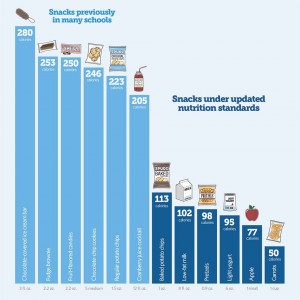Most students cringe at the thought of lunch in school cafeteria. Cafeteria food evokes memories of grey vegetables and smelly meatloaf. Surprisingly, a new study shows that school food is better than you think.
The USDA, which funds and runs school meal programs, saw that schools were feeding children food that was not very nutritious. The USDA promised in the Healthy, Hunger-Free Kids Act of 2010 to improve quality by changing the rules for food served at school.
The impact is huge. Thirty-two million students eat one-half or more of their daily calories through USDA-run school food programs. Since 2010, the food served at schools is healthier and fresher. USDA hopes that healthier, more nutritious food will lead to fewer overweight kids and will reduce the frequency of other serious diseases.

USDA’s new standards also replace many school snack foods with healthier alternatives. The Smart Snacks in Schools standards went into effect during the 2014-2015 school year.
Under the new rules, students eating meals served at school receive one serving of fruit or vegetable with each meal, and can choose two other foods from the grain, milk, fruit/vegetable, and meat groups. The rules also set limits on the amount of salt in meals, and introduce new calorie limits based on grade level.
Parents, students, teachers, and food service workers all argue that these new rules will lead to more food in the trash can instead of in kids’ mouths. But this concern is unfounded. A Harvard study found that students were not throwing away more food under the new rules. Instead, kids were eating more of their meals – including more vegetables! The amount of waste, though still high, did not change much after the new rules were put into place.
The study only looked at food trends in four urban elementary schools, and the amount of food waste continues to be a concern, but these findings are hopeful. If kids are offered unhealthy food, they will eat unhealthy food. If kids are only served healthy food, they will eat the healthy, nutritious food in front of them.
Finally, school food that both kids and parents can feel good about!
“Impact of the New U.S. Department of Agriculture School Meal Standards on Food Selection, Consumption, and Waste,” by Juliana F.W. Cohen, ScM, ScD, Scott Richardson, MBA, Ellen Parker, MBA, MSW, Paul J. Catalano, ScD, Eric B. Rimm, ScD, is published in the American Journal of Preventive Medicine, Volume 46, Issue 4 (April 2014), 388-94, DOI: http://dx.doi.org/10.1016/j.amepre.2013.11.013, published by Elsevier.
Summary by Cynthia C. Bloom